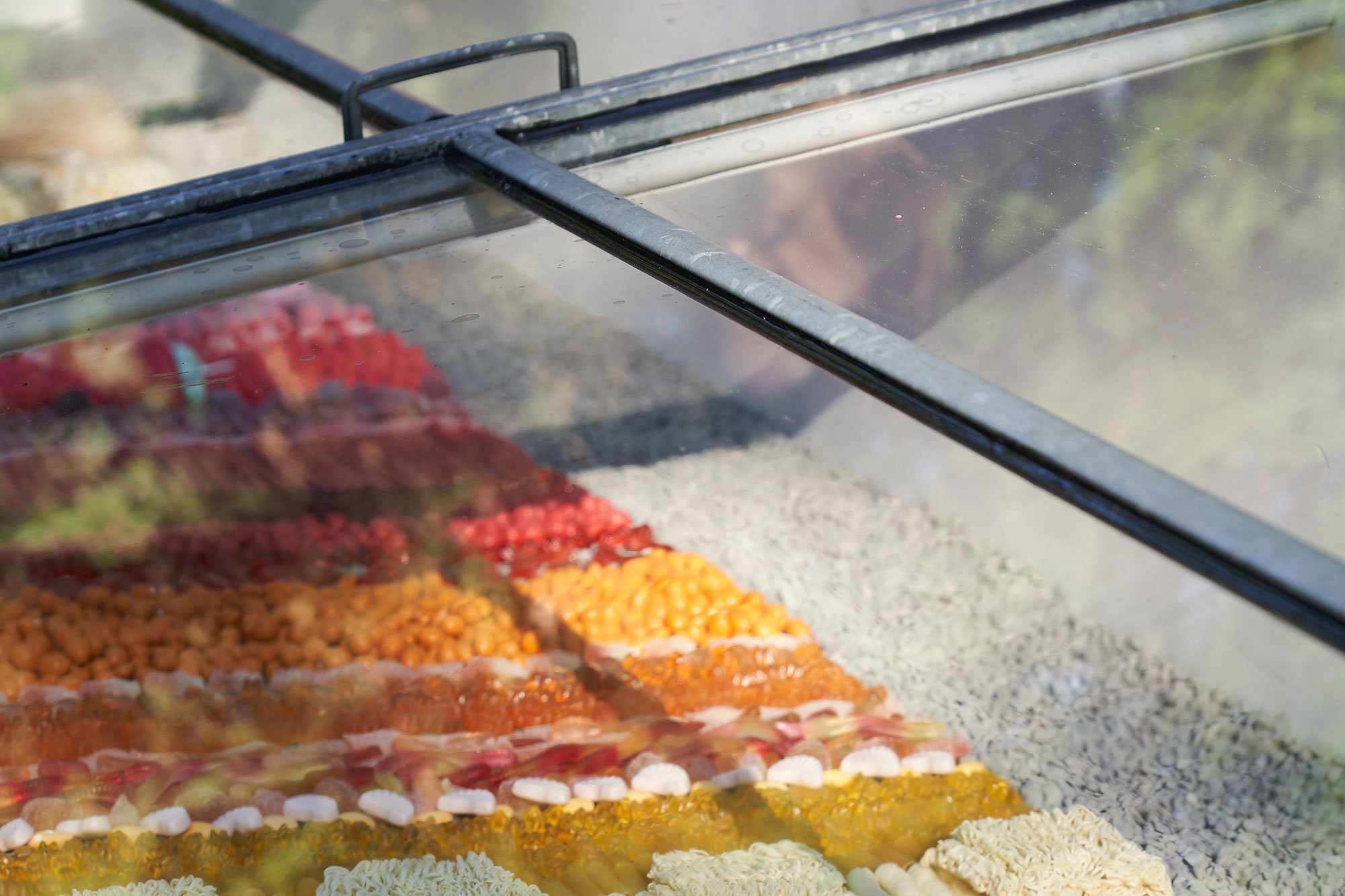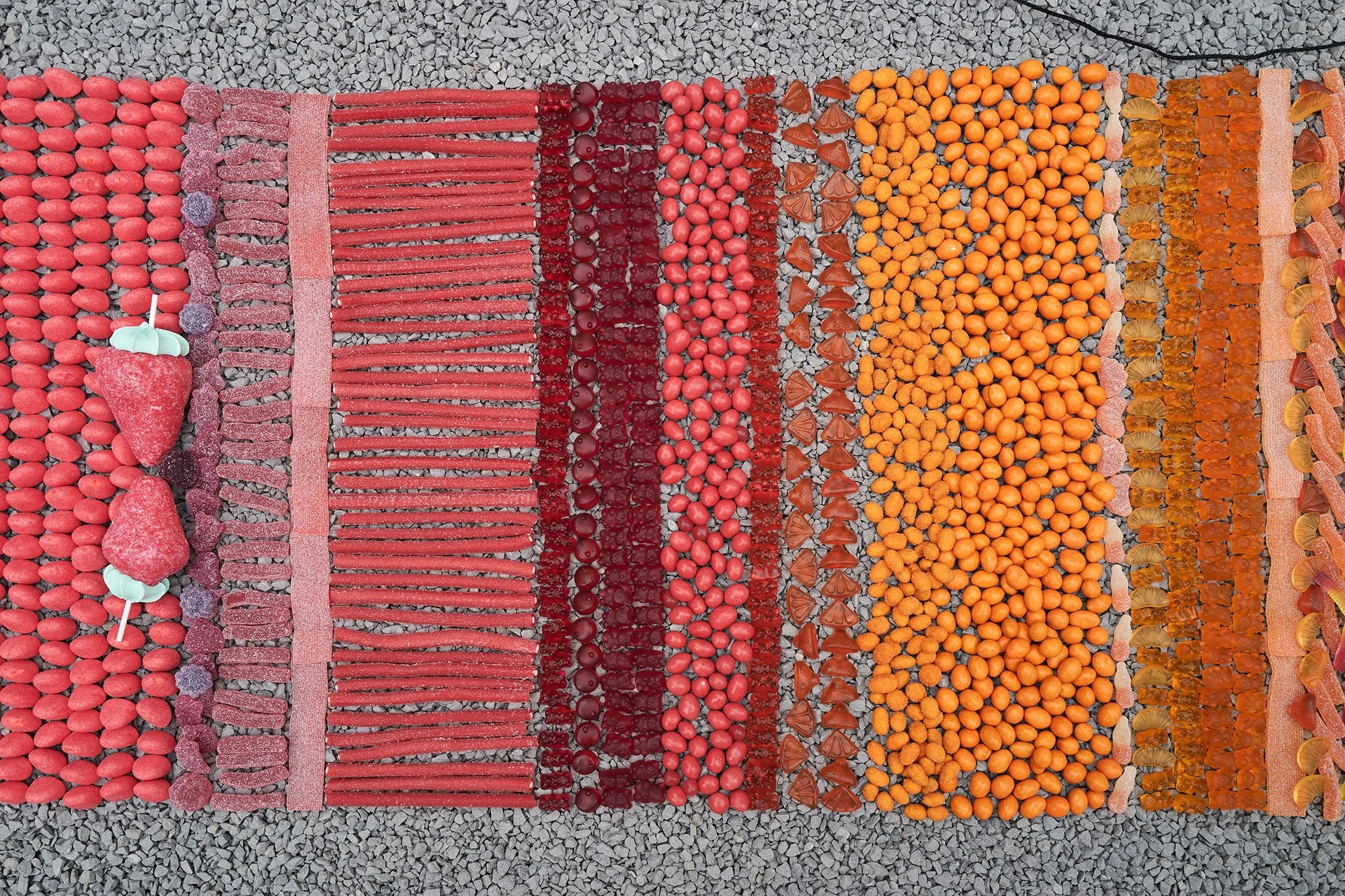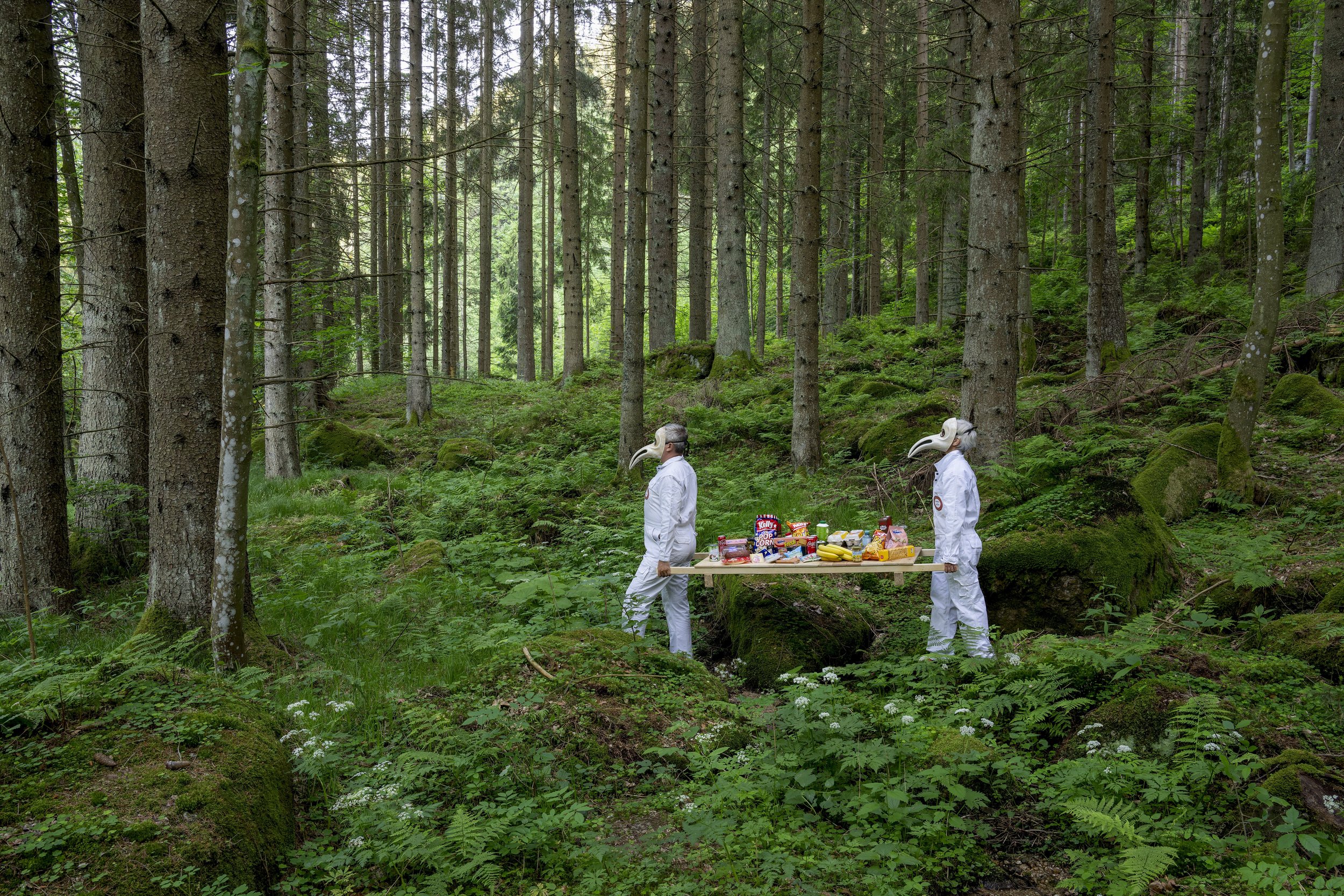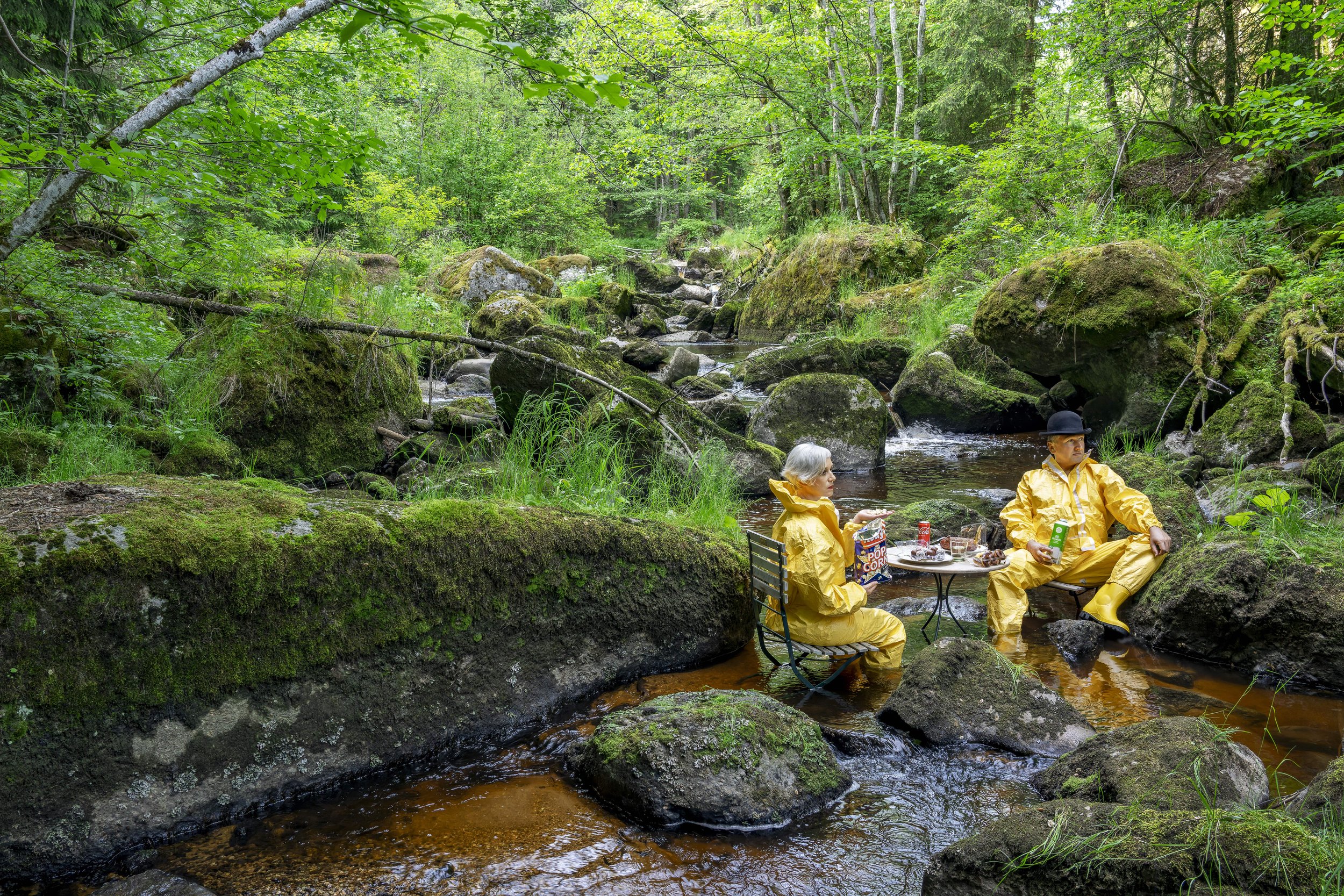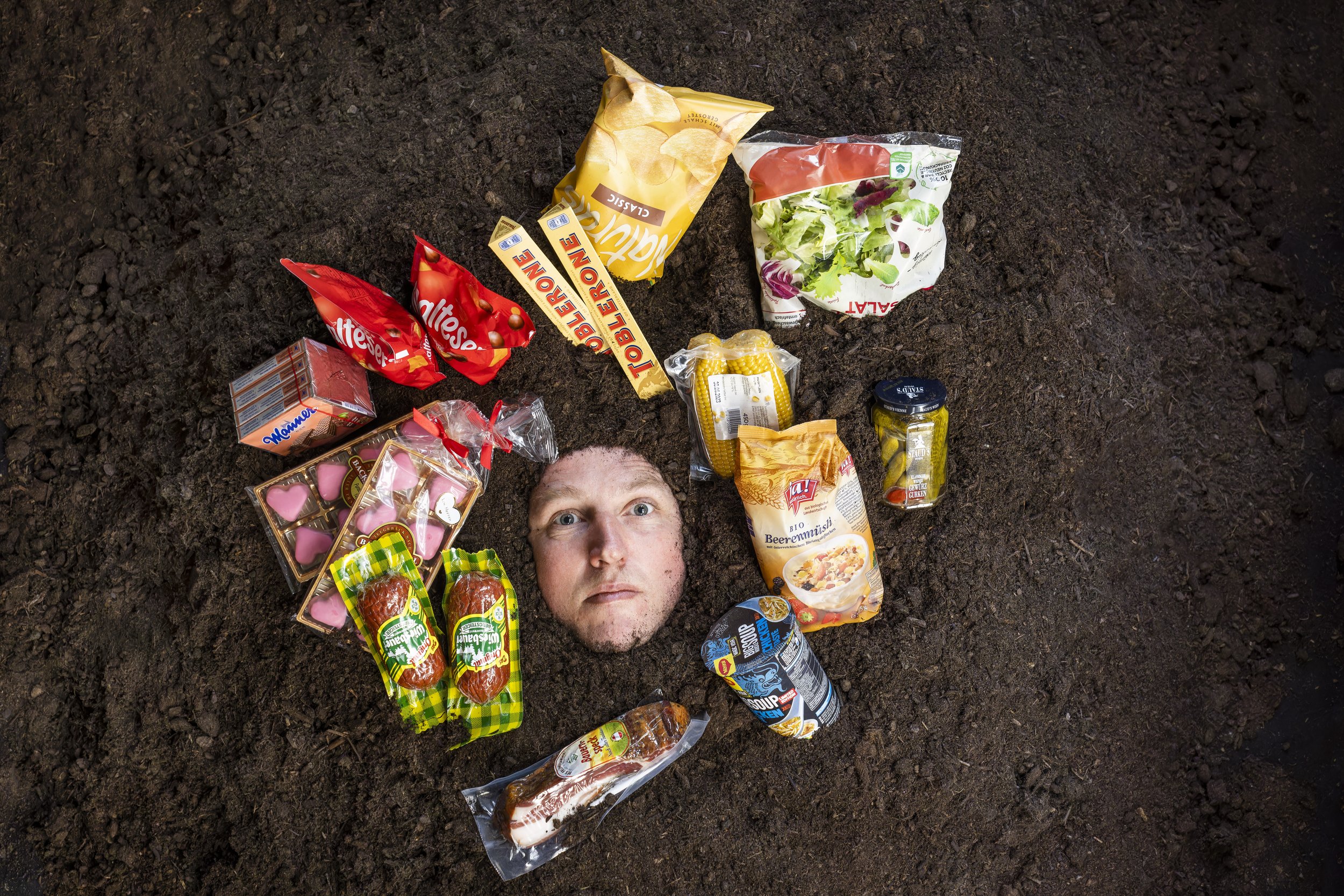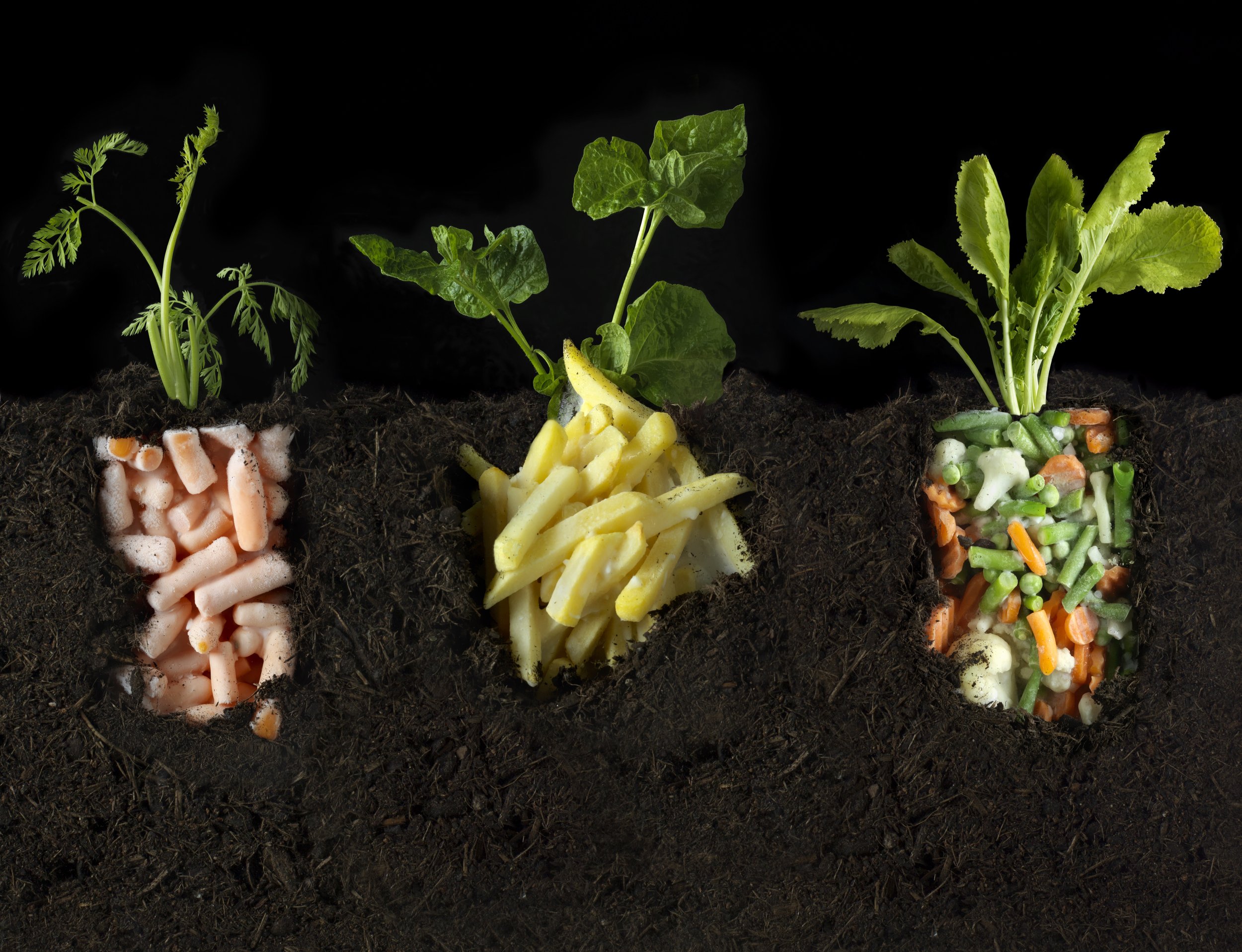VERLIEREN WIR DIE BEHERRSCHUNG? – honey & bunny
VERLIEREN WIR DIE BEHERRSCHUNG?
honey & bunny
In einer Tischvitrine liegt, fein säuberlich nach Farben sortiert, industriell hergestelltes und lange haltbares Essen. Eine Schau unseres Konsums und des Lebensmittelmarktes – grenzenlos im Überfluss. Neben dem Möbel gibt es eine Grube. Die Grundlage von Nahrung wird sichtbar.
Botanische Gärten sind sehr westliche, hegemoniale Orte. Erdacht vom Orden der Jesuiten dienten sie einst dem Erforschen und dem Beherrschen der Welt. Sie offenbarten die grundsätzliche Absicht, sich die Welt untertan zu machen. Beherrschen erfordert Wissen. Allerdings gelang die Umsetzung nicht ganz. Menschen können die Welt, also die Biosphäre, weder beherrschen noch beschützen. Die Menschen sind Teil davon.
Um zu überleben, müssen die Menschen essen. Doch Nahrung ist mehr als Kalorienzufuhr. Die Idee, gemeinsam zu essen, ist vermutlich der Ursprung aller Kultur. Food Design ist die erste Gestaltungsdisziplin. Vielleicht entstanden Städte nur deshalb, weil die Produktion von Nahrungsmitteln dort geplant vonstattengehen konnte. Heute jedenfalls erfordern Bio- und Wirtschaftspolitik, dass immer ausreichend Essen für eine bestimmte Population vorhanden sein muss – oft im Überfluss – das ist Herrschaft.
honey & bunny thematisieren die (vermeintliche) Beherrschung von Natur und die menschlichen Mägen. Sie bringen zeitgenössische Lebensmittel, also Industriedesign, in den alten botanischen Garten und stellen diese den Ideen der Beherrschung gegenüber. Dabei scheinen die darunter liegende Erde, das Erdreich und damit die Grundlage für die Früchte der Biosphäre völlig vergessen zu gehen.
In a table showcase, meticulously arranged by color, rests a display of industrially produced and remarkably durable food items. An exhibition of our consumption and the food market - boundless in abundance. Just next to the furniture, there is a pit. The foundation of food becomes visible.
Botanical gardens are inherently Western and hegemonic places. Conceived by the Jesuit order, they were once used for exploring and exerting dominance over the world. They revealed a fundamental intention to subjugate the world. Mastery requires knowledge. However, the execution was not entirely successful. Humans cannot dominate or protect the world, the biosphere, to be precise. Humans are an integral part of it.
Survival necessitates nourishment. Yet, food is more than just a source of calories. The idea of communal eating is arguably the origin of all culture. Food design is the foundational discipline of design. Perhaps cities emerged solely because they provided a planned setting for food production. In today’s world, organic and economic policies demand a constant supply of sufficient food for a specific population – often in abundance – that is the essence of control.
honey & bunny explore the (perceived) domination of nature and the human stomach. They bring contemporary food, industrial design, into the old botanical garden, contrasting it with the notions of domination. In this process, the underlying earth, soil, and thus the foundation for the fruits of the biosphere seem to be completely overlooked.
Curators’ Comment
Oft konsumieren wir Essen so, wie wir es gewohnt sind. Geprägt durch unsere Gesellschaft ernähren wir uns nach Konventionen. Aus dem Gewächshaus oder aus der Fabrik direkt in den Mund. Food Waste, ökologischer Fussabdruck, alles Begriffe, denen wir täglich begegnen. Trotzdem ertappen wir uns dabei, wie wir Fast Food in Einwegverpackungen konsumieren und sich ein schlechtes Gefühl einschleicht.
Sonja Stummerer und Martin Hablesreiter aus Wien spiegeln in ihrem kritischen Werk den Umgang mit Nahrung und unsere Essensgewohnheiten. Dabei zeigen sie spielerisch und konfrontativ auf, welche Auswirkungen unsere Zubereitungen und unser Konsum auf Umwelt und Natur haben, und was wir vermeintlich als Natur verstehen. Sie halten uns an, unsere Konventionen zu überdenken und Angewohnheiten zu verändern. (Andreas Saxer)
Often, we consume food in the way we are accustomed to. Shaped by our society, we adhere to conventions in our dietary patterns. From the greenhouse or factory directly into our mouths. Terms like “Food Waste” and “ecological footprint” are familiar, yet we still find ourselves consuming fast food in disposable packaging and feeling a sense of unease.
Sonja Stummerer and Martin Hablesreiter from Vienna critically reflect on our approach to food and eating habits in their work. Playfully and confrontationally, they highlight the environmental and natural impacts of our preparations and consumption, challenging our perception of what we consider "natural." They urge us to reconsider our conventions and change our habits. (Andreas Saxer)
Fragebogen Questionary
Wie sieht Euer Arbeitsplatz aus?
Unser Atelier ist eine Wiener Altbauwohnung, an der einmal Egon Schiele vorbei ging.
Welche Themen beschäftigen Euch in Eurer Arbeit?
Soziale und ökologische Nachhaltigkeit und die Würde!
Welche Veränderungen erlebt Ihr in der Designwelt?
Viel zu wenige!
Welches sind Eure Held:innen der Wirklichkeit?
Greta Thunberg. Die Klimakleber:innen. Alle jungen Menschen, die versuchen jene Probleme zu lösen, die wir ihnen gemacht haben.
Weshalb ist Design wichtig?
Design ist DER bestimmende Narrativ der Konsumgesellschaft. Design ist Alltagskultur. Kultur ist immer menschengemacht. Kultur kann jeden Tag verändert werden. Also ist Design ein überaus mächtiger Hebel.
What does your workplace look like?
Our studio is an apartment in an old Viennese building where Egon Schiele once walked by.
Which topics do you deal with in your work?
Social and environmental sustainability and dignity!
What changes are you currently experiencing in the design world?
Way too few!
Who are your heroes in reality?
Greta Thunberg. The climate activists. All the young people who are trying to solve the problems that we have created for them.
Why is design important?
Design is THE defining narrative of consumer society. Design is everyday culture. Culture is always created by humans. Culture can be changed every day.
Über About
honey & bunny, das sind die beiden Wiener:innen Martin Hablesreiter und Sonja Stummerer. In Wien, London und Tokyo haben sie Architektur studiert. Ihr Interesse gilt alltäglichen Dingen und Handlungen wie dem Essen oder dem Putzen. Sie machen auf kulturelle oder politische Aspekte aufmerksam, die sich im scheinbar Banalen verstecken.
honey & bunny are the two Viennese artists Martin Hablesreiter and Sonja Stummerer. They both studied architecture in Vienna, London and Tokyo. They are interested in everyday things and actions such as eating or cleaning and draw attention to cultural or political aspects that are hidden in the seemingly banal.
